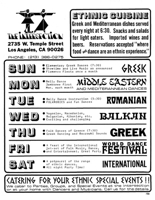
|
The Society of Folk Dance Historians (SFDH)
The Intersection
[
Home |
About |
Encyclopedia | CLICK AN IMAGE TO ENLARGE |

|
BACKGROUND
Information: A folk dance coffeehouse.
ALVARADO STREET
 Four people got together one day toward the end of 1963. They were Louise (Anderson) Bilman, Rudy Dannes, Chalo Holguin, and Marilyn Sage (who later married Chalo). They wanted a place to have more hours of dancing after the regular folk dance groups quit for the night at 10:30 p.m. (the groups stopped at that time because the janitors needed to come in to clean the meeting spaces!).
Four people got together one day toward the end of 1963. They were Louise (Anderson) Bilman, Rudy Dannes, Chalo Holguin, and Marilyn Sage (who later married Chalo). They wanted a place to have more hours of dancing after the regular folk dance groups quit for the night at 10:30 p.m. (the groups stopped at that time because the janitors needed to come in to clean the meeting spaces!).
They put down $3,000.00 to secure a business building at 630 N. Alvarado Street in Los Angeles, California. That was the start of "The Intersection." Although the coffeehouse opened its doors in March, 1964, its official opening was late August.
Rudy did all the artwork. Rudy's mother, Lily, who was very active in the startup of the business, suggested that the front of the building needed curtains and volunteered to make them. Athan Karras, Rudy Dannes, Demo Dafnos, and George Nichols cut the "windows." The group acquired a piano and there was a feta can with a hole in the top on the piano for donations. They all pooled their recordings to play for music.
Louise and others would go down to the Long Beach harbor, recruit sailors from Greek ships, and bring them up to The Intersection to dance. They also brought in girls from the University of California Los Angeles (UCLA) to dance with them.
Of course, there was lemon-lime or Coke to wash down the shish-ke-bab. Ethnic cuisine was available, such as Greek and Mediterranean dishes, plus snacks, salads, wines, and beers. Everyone was asked to take dishes and silverware back to the kitchen, where they could be washed for someone else's use. Dance music was available at "The I" for purchase.
Dick Oakes began teaching a couple dance class for advanced Balkan dancers on Monday evenings. As "The I" got going, more classes were formed until an entire week's agenda was available.
Soon, The Intersection moved to a new building at 2735 W. Temple Street, still in Los Angeles, and headed by Athan Karras and Rudy Dannes. The storefront off the 101 "Hollywood" Freeway instantly became a stomping ground for folk dancers from all over. Along with them came new recruits and people discovering folk dancing for the first time. All sorts of names dropped in, such as Omar Sharif, Telly Savalas, Ginger Rogers, and John Raitt.
Ancient animosities were forgotten and bloodlines became blurred: Arabs danced with Jews, Turks with Greeks. A meticulously dressed Japanese businessman led a Greek butcher's dance, followed by a long-haired Anglo boy hanging on, who was followed by a lanky, loose Black. Three ensemble groups were formed and gave performances not only at The Intersection, but all over Southern California. The Intersection was constantly striving to become a beautiful weaving of intersecting cultures. In some cases they achieved it; in other cases they only superficially touched it, but in every case they tried to create an authentic atmosphere.
CLOSING
The Intersection closed twenty years after its beginning with a huge, final New Year's Eve Party on December 31, 1984.
REUNION
At the 2010 Intersection Reunion, which saw more than 300 participants, Louise related, "I remember how dynamic it was from the very beginning and how well people related to each other. People looked at each other as friends; we were making connections and that is so important. These connections are the foundations of what brings all this group together; we have connections in love, and I would like to emphasize that."
SPAWNED
The business gave rise to many other coffeehouses, such as:
- Adana Center
- Aitos
- Ashkenaz
- Athens by Night
- Café AMAN
- Café Ămi
- Cafe Danssa
- Cafe Shalom
- Calliópe's
- Dance Art Center
- Diedrich's
- Experience / Luz' Place
- Finjan
- Folk Dance Cabaret
- Gypsy Camp (Sunset Blvd.)
- Gypsy Camp (Motor Ave.)
- Highland
- Hadarim Folk Cafe
- Horo
- Jericho
- Mandala
- Museum
- Open Circle
- Other Place
- Plaka
- Red Mill House
- Scorpio's
- Source
- Theo's Tavern
- Threshing Floor
- Valley Intersection
- Veselo Selo
- Zorbas
- Athens Intersection
and the short lived
DOCUMENTS
- Athan Karras, an article.
- Dick Oakes, an article.
This page © 2018 by Ron Houston.
Please do not copy any part of this page without including this copyright notice.
Please do not copy small portions out of context.
Please do not copy large portions without permission from Ron Houston.
